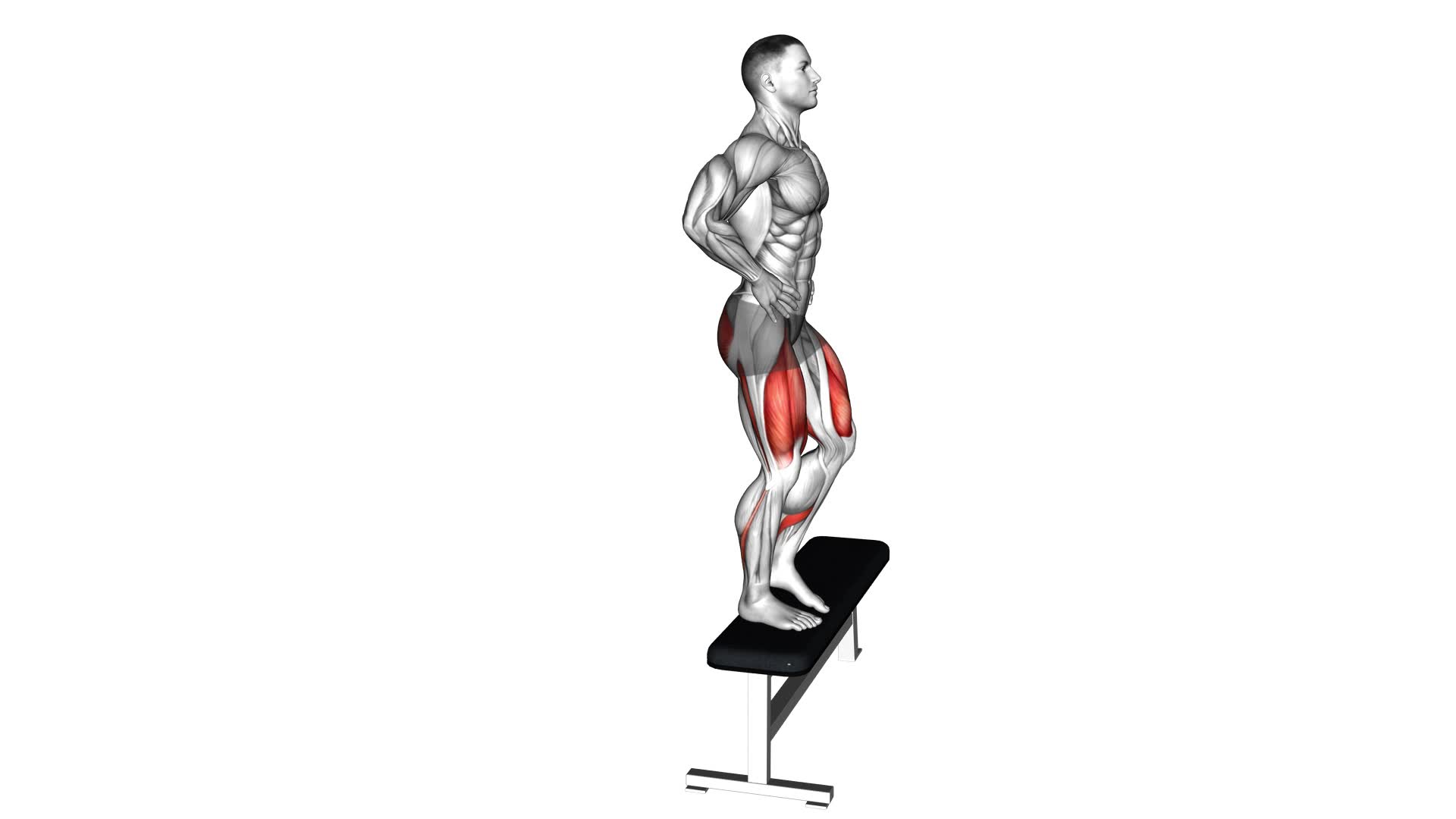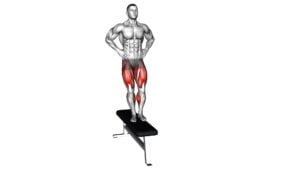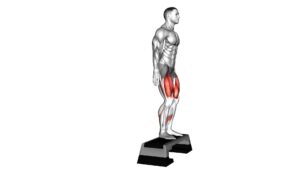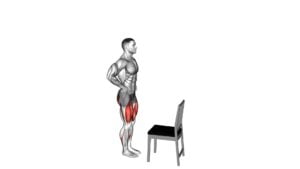Bodyweight Step-up (VERSION 2) (male) – Video Exercise Guide & Tips

Looking to amp up your workout routine?
Watch This Exercise Video
Check out this video exercise guide for the Bodyweight Step-up (Version 2) (male).
Discover the benefits, learn proper form and technique, explore variations and progressions, and avoid common mistakes.
With these tips, you'll be able to easily incorporate the Bodyweight Step-up (Version 2) (male) into your workouts.
Get ready to take your fitness to the next level!
Key Takeaways
- Bodyweight step-up (Version 2) engages multiple muscle groups including quadriceps, hamstrings, glutes, and calves.
- It improves lower body strength, stability, and cardiovascular fitness.
- The exercise can be done anywhere, anytime with no equipment required.
- Adding variations and progressions to the exercise can continuously challenge and stimulate muscles.
Benefits of Bodyweight Step-up (VERSION 2) (male)
You can experience multiple benefits by incorporating bodyweight step-ups (VERSION 2) into your workout routine.
One of the key benefits is the muscle engagement that this exercise provides. When performing bodyweight step-ups, your quadriceps, hamstrings, glutes, and calves are all actively engaged as you lift your body weight with each step. This helps to strengthen and tone these muscles, improving overall lower body strength and stability.
In addition to muscle engagement, bodyweight step-ups also offer cardiovascular benefits. By performing this exercise in a continuous and controlled manner, you can elevate your heart rate and increase your cardiovascular endurance. This can help improve your overall cardiovascular health and stamina, making it easier to perform everyday activities and other exercises.
Incorporating bodyweight step-ups (VERSION 2) into your workout routine is a practical and effective way to target multiple muscle groups while also getting your heart rate up. Whether you're looking to build strength, improve endurance, or simply add variety to your workouts, this exercise is a great choice.
Remember to start with a comfortable step height and gradually increase the challenge as you get stronger. So, lace up your sneakers and give bodyweight step-ups a try for a full-body workout that will leave you feeling strong and energized.
Proper Form and Technique for Bodyweight Step-up (VERSION 2) (male)
To perform the bodyweight step-up (VERSION 2) (male) with proper form and technique, it's important to maintain a stable and controlled movement throughout the exercise. This will help you avoid common injuries that can occur during this exercise. One of the most common injuries is knee pain. To prevent this, make sure you keep your knee in line with your foot as you step up and down. Avoid letting your knee cave inward or go too far past your toes.
Another common injury is lower back strain. To protect your back, engage your core muscles and keep your torso upright throughout the movement.
To increase the difficulty of the bodyweight step-up (VERSION 2) (male) exercise, you can try a few modifications. First, you can add weights by holding dumbbells or a barbell on your shoulders. This will increase the resistance and challenge your muscles more.
Another option is to increase the height of the step. Use a higher platform or step to require more strength and stability.
Additionally, you can try performing the exercise explosively by jumping up onto the step and landing softly. This will engage your muscles more and elevate your heart rate.
Remember to always start with proper form and gradually progress to more challenging variations to avoid injury and get the most out of your workout.
Variations and Progressions for Bodyweight Step-up (VERSION 2) (male)
To progress the bodyweight step-up (VERSION 2) (male), try incorporating different variations to challenge your muscles even further. You can use different equipment options to add complexity to this exercise. For example, you can perform the step-up using dumbbells or kettlebells held in each hand, which will increase the resistance and target your muscles more intensely. Another option is to use a weighted vest or ankle weights to make the exercise more challenging.
In addition to equipment variations, there are advanced variations you can try to further push your limits. One option is the explosive step-up, where you explosively push off your stepping leg to increase power and speed. Another variation is the lateral step-up, where you perform the exercise by stepping laterally onto the elevated surface, targeting your adductor muscles.
By incorporating these different equipment options and advanced variations, you can continue to challenge and stimulate your muscles during the bodyweight step-up (VERSION 2) (male).
Now that you have learned about the variations and progressions, let's move on to the next section and discuss the common mistakes to avoid during the bodyweight step-up (VERSION 2) (male).
Common Mistakes to Avoid During Bodyweight Step-Up (Version 2) (Male)
As we continue the discussion from the previous subtopic, let's now focus on the common mistakes to avoid during the bodyweight step-up (Version 2) (male). By being aware of these mistakes and knowing how to avoid them, you can maximize the effectiveness and safety of this exercise.
One common mistake during the bodyweight step-up is using incorrect form. It's important to maintain proper alignment throughout the movement. Keep your chest up, shoulders back, and core engaged. Avoid leaning forward or allowing your knees to collapse inwards. This will help prevent unnecessary strain on your joints and muscles.
Another mistake to avoid is using too much momentum. The goal of the bodyweight step-up is to challenge your muscles, not rely on momentum to complete the movement. Make sure to control the ascent and descent, focusing on engaging the muscles in your legs and glutes.
Lastly, don't forget to use the appropriate step height. Using a step that's too high can put excessive strain on your knees, while a step that's too low may not provide enough resistance. Choose a step height that allows you to perform the exercise with proper form and challenges your muscles.
Tips for Incorporating Bodyweight Step-Up (Version 2) (Male) Into Your Workout Routine
Continue maximizing the effectiveness and safety of your bodyweight step-up (Version 2) (male) exercise by incorporating these helpful tips into your workout routine:
- Incorporate weights: To increase the intensity of your bodyweight step-ups, consider adding weights. You can hold dumbbells or kettlebells in each hand while performing the exercise. Start with lighter weights and gradually increase as you become more comfortable and stronger.
- Advanced modifications: Once you have mastered the basic bodyweight step-up, challenge yourself with advanced modifications. Try performing the exercise on an unstable surface like a balance board or Bosu ball. This will engage your core and improve your balance. You can also incorporate plyometric variations by explosively pushing off the ground with your leading leg, switching legs mid-air, and landing softly.
- Alternate leg heights: Varying the height of the step can target different muscles and add variety to your routine. Start with a lower step and gradually progress to a higher one. This will engage your glutes, quads, and hamstrings in different ways, providing a well-rounded lower body workout.
Incorporating these tips into your bodyweight step-up routine will help you continue challenging your muscles, prevent plateauing, and achieve optimal results. Remember to always maintain proper form and listen to your body to avoid injury.
Frequently Asked Questions
How Many Calories Does the Bodyweight Step-Up (Version 2) (Male) Burn?
When you perform the bodyweight step-up (version 2) as a male, you can expect to burn calories. This exercise engages multiple muscle groups, including your legs and glutes, which helps to increase your calorie burn.
However, it's important to note that the exact number of calories burned will vary depending on factors such as your weight and intensity level. Additionally, it's crucial to maintain proper form to avoid any knee pain during the exercise.
Can I Perform the Bodyweight Step-Up (Version 2) (Male) if I Have Knee Pain?
Yes, you can modify the bodyweight step-up (version 2) if you have knee pain. It's important to prioritize your safety and listen to your body.
To modify the exercise, you can decrease the height of the step or use a lower platform. Alternatively, you can try other exercises that don't put as much strain on your knees, such as lunges, glute bridges, or seated leg extensions.
Remember to consult with a healthcare professional or a certified trainer for personalized advice.
How Does the Bodyweight Step-Up (Version 2) (Male) Compare to Other Lower Body Exercises?
The bodyweight step-up (version 2) (male) is a great lower body exercise that targets your quads, glutes, and hamstrings. It's a bodyweight exercise that helps improve leg strength and stability.
When compared to weighted squats, the bodyweight step-up (version 2) (male) offers a different challenge by focusing on single-leg strength and balance.
Compared to lunges, the bodyweight step-up (version 2) (male) requires more stability and control.
Incorporating both exercises into your routine can help build overall lower body strength.
Is It Necessary to Use a Bench or Can I Use a Different Elevated Surface for the Step-Up?
You don't necessarily have to use a bench for the bodyweight step-up. There are alternative elevated surfaces you can use to perform this exercise. Using a different surface can add variety to your workout routine and target different muscles in your lower body.
It's important to choose a stable and sturdy surface that's at a suitable height for your fitness level. Be sure to maintain proper form and technique to maximize the benefits of the step-up exercise.
Can I Perform the Bodyweight Step-Up (Version 2) (Male) Without Any Equipment?
Yes, you can perform the bodyweight step-up (version 2) (male) without any equipment. This exercise targets your lower body muscles, specifically your glutes, quads, and hamstrings. It helps improve your leg strength, balance, and stability.
To perform it without equipment, you can use a stair, a sturdy box, or any elevated surface that can support your weight. Remember to maintain proper form and start with a height that's comfortable for you.
Conclusion
In conclusion, the bodyweight step-up (version 2) is a beneficial exercise for males looking to improve lower body strength and stability. By maintaining proper form and technique, individuals can avoid common mistakes and maximize the effectiveness of the workout.
With variations and progressions available, this exercise can be tailored to individual fitness levels and goals. By incorporating the bodyweight step-up (version 2) into your workout routine, you can enhance your overall fitness and achieve your desired results.

Author
Years ago, the spark of my life’s passion ignited in my mind the moment I stepped into the local gym for the first time. The inaugural bead of perspiration, the initial endeavor, the very first surge of endorphins, and a sense of pride that washed over me post-workout marked the beginning of my deep-seated interest in strength sports, fitness, and sports nutrition. This very curiosity blossomed rapidly into a profound fascination, propelling me to earn a Master’s degree in Physical Education from the Academy of Physical Education in Krakow, followed by a Sports Manager diploma from the Jagiellonian University. My journey of growth led me to gain more specialized qualifications, such as being a certified personal trainer with a focus on sports dietetics, a lifeguard, and an instructor for wellness and corrective gymnastics. Theoretical knowledge paired seamlessly with practical experience, reinforcing my belief that the transformation of individuals under my guidance was also a reflection of my personal growth. This belief holds true even today. Each day, I strive to push the boundaries and explore new realms. These realms gently elevate me to greater heights. The unique combination of passion for my field and the continuous quest for growth fuels my drive to break new ground.







